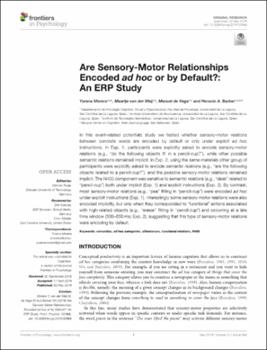Are sensory-motor relationships encoded ad hoc or by default?: an ERP study
Date
2019Abstract
In this event-related potentials study we tested whether sensory-motor relations
between concrete words are encoded by default or only under explicit ad hoc
instructions. In Exp. 1, participants were explicitly asked to encode sensory-motor
relations (e.g., “do the following objects fit in a pencil-cup?”), while other possible
semantic relations remained implicit. In Exp. 2, using the same materials other group of
participants were explicitly asked to encode semantic relations (e.g., “are the following
objects related to a pencil-cup?”), and the possible sensory-motor relations remained
implicit. The N400 component was sensitive to semantic relations (e.g., “desk” related to
“pencil-cup”) both under implicit (Exp. 1) and explicit instructions (Exp. 2). By contrast,
most sensory-motor relations (e.g., “pea” fitting in “pencil-cup”) were encoded ad hoc
under explicit instructions (Exp. 1). Interestingly some sensory-motor relations were also
encoded implicitly, but only when they corresponded to “functional” actions associated
with high-related objects (e.g., “eraser” fitting in “pencil-cup”) and occurring at a late
time window (500–650 ms; Exp. 2), suggesting that this type of sensory-motor relations
were encoding by default.






